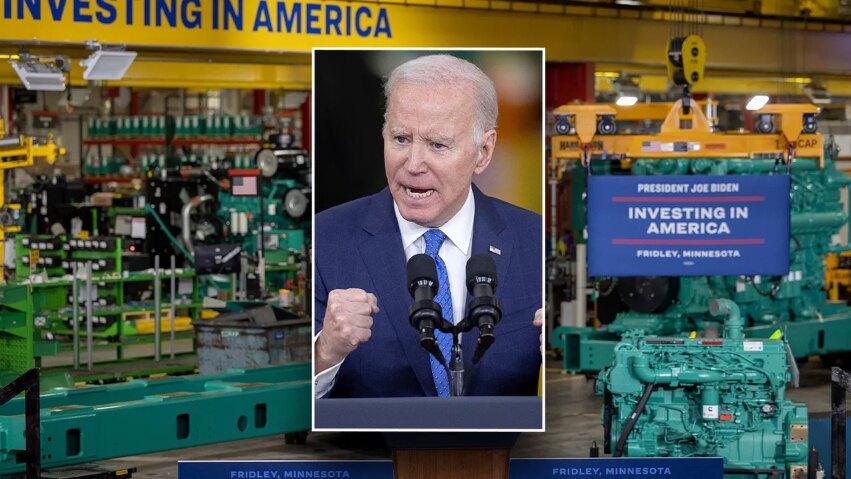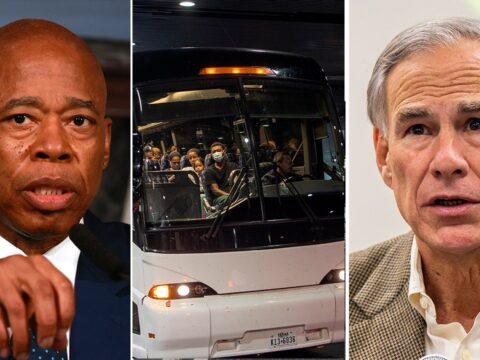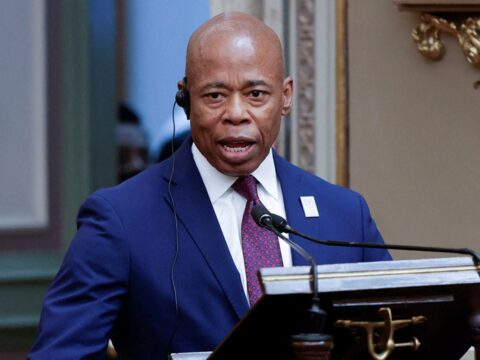The White House unveiled highly anticipated guidance placing significant restrictions on the type of hydrogen power development eligible for generous federal tax credits.The proposed guidance, released Friday morning in a joint announcement by the White House, Treasury Department and Department of Energy, tethers the 2022 Inflation Reduction Act’s (IRA) highest production credit of $3 per kilogram of hydrogen produced to tight green energy standards. The restrictions had been supported by environmentalists and some green energy companies but opposed by business and clean power industry groups.”The Inflation Reduction Act’s hydrogen tax credit will help build a clean hydrogen industry that will be critical in reducing emissions from harder-to-decarbonize sectors like heavy industry and heavy transportation,” John Podesta, President Biden’s clean energy czar, said in a statement.GOP REPORT HIGHLIGHTS 2023 ENERGY, OVERSIGHT WINS OVER ‘UNREALISTIC CLIMATE AGENDA’ President Biden visits the Cummins Power Generation Facility as part of his administration’s Investing in America tour in Fridley, Minn., April 3, 2023. (Elizabeth Flores/Star Tribune via Getty Images)”Today’s announcement will further unprecedented investments in a new, American-led industry as we aim to lead and propel the global clean energy transition,” added Energy Secretary Jennifer Granholm. “Hydrogen has the potential to clean up America’s manufacturing industry, power the transportation sector and shore up our energy security all while delivering good-paying jobs and new economic opportunity to communities in every pocket of America.”Hydrogen has been widely pegged as a key technology for reducing future greenhouse gas emissions, especially in hard-to-decarbonize sectors like shipping, heavy trucking and cement and steel manufacturing. The transportation and industrial sectors account for nearly 60% of U.S. end-use emissions.Overall, the hydrogen production tax credits are some of the most generous clean energy incentives earmarked under the IRA, Democrats’ massive climate and tax bill President Biden signed in August 2022, and are worth up to $100 billion. The legislation marked the nation’s most ambitious effort yet to spur the growth of hydrogen generation, which remains a nascent technology requiring billions of dollars in investment to achieve large-scale production.BIDEN ADMIN AIMS TO PUSH TOWNS, CITIES TO ADOPT GREEN ENERGY BUILDING CODES: ‘VERY SUSPICIOUS’However, the formulation of the tax credits has sparked an intense debate in recent months, leading to delays in issuing Friday’s guidance, as a result of the potential carbon emissions produced in the production of hydrogen. The credits will be available for 10 years, starting on the date a hydrogen production facility is placed into service for projects that begin construction before 2033.The IRA includes four tiers of credits, ranging from $0.60 per kilogram to $3 per tier, which are determined based on the carbon intensity of that production.A common pathway for hydrogen production, for example, is electrolysis, a process by which hydrogen is split from water using an electric current. While the only emissions from that process are hydrogen and oxygen, environmentalists have argued that hydrogen reliance could be rendered pointless if the electricity is generated from fossil fuel-fired sources.”The Clean Hydrogen Production Credit aims to make production of clean hydrogen with minimal climate pollution more economically competitive and accelerate development of the U.S. clean hydrogen industry,” the Treasury Department said Friday. “Today’s proposed regulations advance those goals and will support the development of a robust U.S. clean hydrogen industry that creates good-paying jobs, while also reducing carbon emissions.” Energy Secretary Jennifer Granholm hosts a news conference in December 2022. (REUTERS/Mary F. Calver/File Photo)Under the guidance, hydrogen producers are only eligible for the highest tax credit if electricity is generated from a green energy source, such as wind and solar, that came online within three years of a new facility being placed into service. That provision means a facility fueled by green energy that has been operational for more than three years is ineligible for the credit.In addition, the guidance requires that, beginning in 2028, hydrogen developers’ electricity generation is sourced from a clean source on an hourly basis, the most stringent timescale. In other words, the electricity generated for electrolysis must be produced within an hour of hydrogen production from that electricity.BIDEN ADMIN HIT WITH LEGAL CHALLENGE OVER GAS APPLIANCE CRACKDOWNAnd the final key provision for hydrogen produced using electricity mandates clean energy is sourced from a project in the same region.”The proposed 45V rules represent a major milestone in determining tax credits on a technology neutral basis, ensuring the life cycle emissions analysis required by statute will be accurate, account for system-wide impacts and avoid wasteful subsidies for electrolytic hydrogen projects that are purportedly clean but actually use dirty electricity,” said Mike Kaercher, the director of the Climate Tax Project at the Tax Law Center at NYU Law.”Experts have estimated that lax rules could have locked in hundreds of millions of additional tons of carbon emissions in the long run.” A CF Industries fertilizer complex is pictured in Donaldsonville, La., June 30, 2022. (Emily Kask for The Washington Post via Getty Images)However, the proposal is facing significant pushback from industry groups and hydrogen companies that have argued for the federal government to begin implementation of the IRA tax credits with lax guidance to incentivize greater investment and development in the near term. Groups like the U.S. Chamber of Commerce, the Fuel Cell and Hydrogen Energy Association (FCHEA) and the Clean Hydrogen Future Coalition, in addition to hydropower and nuclear groups, have argued strict regulations like those unveiled Friday will deter investment, increase the cost of hydrogen, lead to fewer projects in the coming years and discriminate against existing low-carbon power sources.MAINE FORCED TO DELAY VOTE ON EV MANDATE AMID WIDESPREAD POWER OUTAGES”The guidance announced today by the Biden-Harris administration will place unnecessary burdens on the still nascent clean hydrogen industry,” FCHEA President and CEO Frank Wolak said Friday. “The nation needs commonsense solutions for this tax credit that are aligned with the congressional intent to spur robust economic development and create jobs while reducing carbon emissions. “Congress intended the tax credit to spur domestic clean hydrogen production and allow the United States to maintain an international competitive advantage, not to be an inadvertent backdoor to regulate use of the electric utility grid,” he added. “The United States cannot achieve its climate goals without clean hydrogen, and these proposed regulations and requirements will unnecessarily hold back our domestic industry, driving investment, manufacturing and technology leadership overseas.” Sen. Tom Carper, D-Del., chairman of the Senate Environment and Public Works Committee, wrote last month that “by avoiding overly stringent requirements, we can nurture innovation, support the growth of clean hydrogen and the newly funded hubs and accelerate our clean energy transition.” (Al Drago/Bloomberg via Getty Images)Marty Durbin, the president of the U.S. Chamber’s Global Energy Institute, said the guidance will “stunt the growth of a critical industry before it has even begun.”Andy Marsh, the CEO of hydrogen fuel cell systems developer Plug Power, added the framework will “fall woefully short in achieving the administration’s decarbonization objectives.”Meanwhile, the guidance is likely to also face congressional opposition, including from several Senate Democrats who have argued the IRA was designed to allow for a slow phase-in of stringent guidance.CLICK HERE TO GET THE FOX NEWS APP”Overly prescriptive guidance could prevent the growth and certainty needed for clean hydrogen to provide meaningful alternatives for difficult to decarbonize sectors, reach competitive hydrogen market prices, and realize the more than 100,000 new jobs the Energy Department projects the clean hydrogen industry could create by 2030,” a group of 11 Senate Democrats wrote to Treasury Secretary Janet Yellen, Podesta and Granholm on Nov. 6.Senators Maria Cantwell, D-Wash.; Sherrod Brown, D-Ohio; Joe Manchin, D-W.Va.; Dick Durbin, D-Ill.; Kirsten Gillibrand, D-N.Y.; Patty Murray, D-Wash.; John Fetterman, D-Pa.; Tammy Duckworth, D-Ill.; Kyrsten Sinema, D-Ariz.; Bob Casey, D-Pa.; and Gary Peters, D-Mich., all signed onto the letter.Senate Environment and Public Works Committee Chairman Tom Carper, D-Del., sent a similar letter three days later. Thomas Catenacci is a politics writer for Fox News Digital.





















